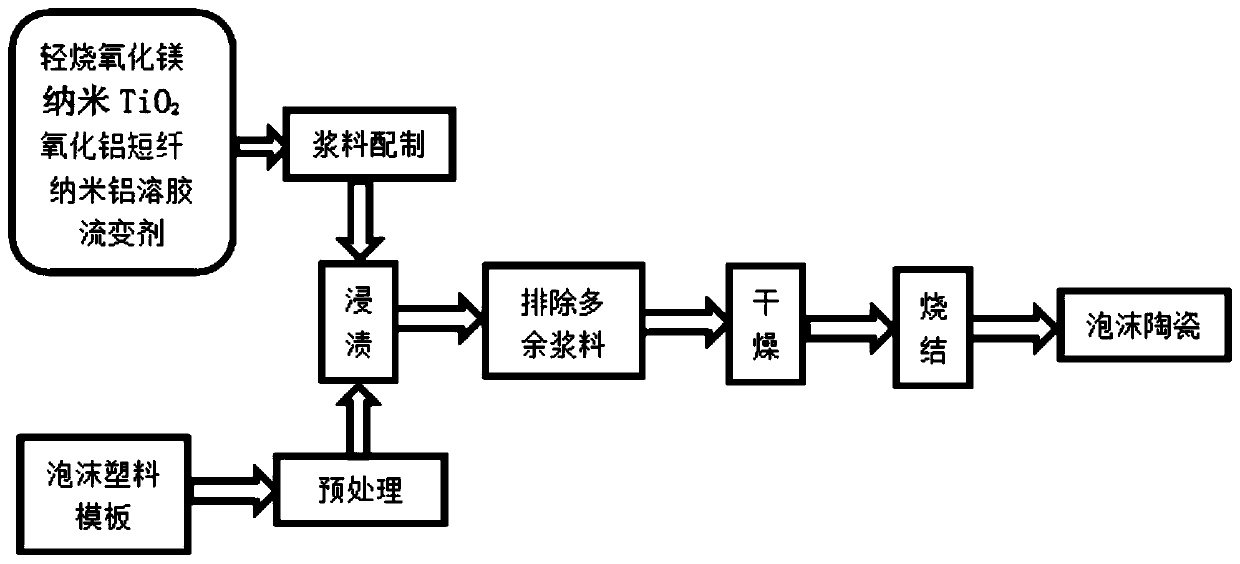A kind of alumina short fiber reinforced magnesia-based ceramic foam filter and preparation method thereof
A magnesia-based ceramic and foam ceramic technology, which is applied to alumina short fiber reinforced magnesia-based foam ceramic filter and preparation thereof, filtration and purification of aluminum and its alloy melt, magnesia-based foam ceramic filter and preparation thereof It can solve the problems of operation limitation, increase the lattice distortion and instability of the matrix magnesium oxide, and achieve the effects of good strength, simple process and low cost.
- Summary
- Abstract
- Description
- Claims
- Application Information
AI Technical Summary
Problems solved by technology
Method used
Image
Examples
Embodiment 1
[0052] According to the ratio of nano-titanium oxide accounting for 1% of the mass of the ceramic powder and commercial alumina short fibers (about 10 μm to 20 μm in diameter and 50 μm to 100 μm in length) accounting for 1% of the mass of the ceramic powder, the particle size was weighed to be 30 nm. Nano-titanium oxide, commercial alumina short fibers and a particle size of 250 mesh (middle diameter d 50 Prepare ceramic powder for lightly burned magnesia powder with a thickness of 58 μm; mix and prepare a rheological agent according to the mass ratio of polyvinyl butyral and hydroxypropyl methylcellulose at a ratio of 1:1.
[0053] According to mass percentage, 15% of nano-alumina sol with a solid content of 20% (select a commercial nano-alumina sol with a nearly neutral pH value, the same below), 0.8% of rheological agent, and the rest are ceramic powders for batching. First, add the light-burned magnesia powder into the ball mill tank according to the ratio, and add nano-al...
Embodiment 2
[0057] According to the ratio that nano-titanium oxide accounts for 2% of the mass of the ceramic powder, and alumina short fibers account for 3% of the mass of the ceramic powder, the nano-titanium oxide with a particle size of 60nm, commercial alumina short fibers and a particle size of 60nm are weighed. 500 mesh (middle diameter d 50Prepare ceramic powder for lightly burned magnesia powder (25 μm); mix and prepare rheological agent according to the mass ratio of polyvinyl butyral and hydroxypropyl methylcellulose at a ratio of 1:1.
[0058] According to mass percentage, 20% of nano-aluminum sol with a solid content of 25%, 1.5% of rheological agent, and the rest are ceramic powder for batching. First, add the light-burned magnesia powder into the ball mill tank according to the proportion, mix the nano-alumina sol, nano-titanium dioxide, alumina short fiber, rheological agent and an appropriate amount of absolute ethanol and ultrasonically treat it for 60 minutes to make th...
Embodiment 3
[0062] According to the ratio that nano-titanium oxide accounts for 1.5% of the ceramic powder mass, and alumina short fibers account for 2% of the ceramic powder mass, the nano-titanium oxide with a particle size of 50nm, commercial alumina short fibers and a particle size of 325 mesh (middle diameter d 50 Prepare ceramic powder for lightly burned magnesia powder (45 μm); mix and prepare rheological agent according to the mass ratio of polyvinyl butyral and hydroxyethyl cellulose at a ratio of 1:1.
[0063] According to mass percentage, 25% of nano-alumina sol with a solid content of 22%, 1.0% of rheological agent, and the rest are ceramic powder for batching. First, add the light-burned magnesia powder into the ball mill tank according to the proportion, mix the nano-alumina sol, nano-titanium dioxide, alumina short fiber, rheological agent and an appropriate amount of absolute ethanol and ultrasonically treat it for 45 minutes to make the alumina short-fiber powder After t...
PUM
| Property | Measurement | Unit |
|---|---|---|
| particle size (mesh) | aaaaa | aaaaa |
| particle diameter | aaaaa | aaaaa |
| diameter | aaaaa | aaaaa |
Abstract
Description
Claims
Application Information
 Login to View More
Login to View More - R&D
- Intellectual Property
- Life Sciences
- Materials
- Tech Scout
- Unparalleled Data Quality
- Higher Quality Content
- 60% Fewer Hallucinations
Browse by: Latest US Patents, China's latest patents, Technical Efficacy Thesaurus, Application Domain, Technology Topic, Popular Technical Reports.
© 2025 PatSnap. All rights reserved.Legal|Privacy policy|Modern Slavery Act Transparency Statement|Sitemap|About US| Contact US: help@patsnap.com



